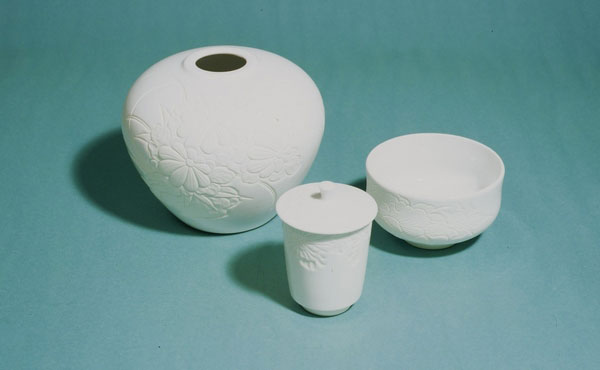
- Ceramic
- Hyogo
Izushi ware Izushi yaki
Unique pure white completed gradually over the years
Simple, cool, clear and delicate white porcelain
Description
What is Izushi ware ?
Izushi ware (called
History
It is said that the start of Izushi ware was in 1764, when a potter named Yazaemon IZUYA established a glaze kiln that produced pottery in Izushi. Then, Chinzaemon NIHACHIYA resolved to start producing porcelain and went to Arita, Saga prefecture with backing from the Izushi domain in order to learn production techniques. Subsequently, he returned with a potter from Arita ware, but financial difficulties led to Nihachiya moving away from Izushi. The potter remained in the town and carried out Chinzaemon's wishes by becoming an artisan in unglazed earthenware and teaching others the production process.
Although the Izushi domain set out to manage the kilns directly, this was more difficult than anticipated. During the latter half of the Edo period (1603-1868), the ceramics industry in Izushi developed with the establishment of an elite organization centered around working artisans from an Arita ware kiln. The discovery of large quantities of white porcelain ore helped this craft to continue to improve. As a result, the organization successfully produced a new kind of white porcelain, winning gold prize at the St. Louis World's Fair in 1904, and thus Izushi ware came to be known on a global scale.
General Production Process
- 1. Production of materials The porcelain stone that is used as raw material is a general term for rock, and normally consists of 70% quartz and 30% sericite. When this porcelain stone is hardened by mashing and kneading, a clay-like elasticity is produced. This material, known as kaolin, was in the past produced by individual artisans, but now is made by batch production.
- 2. Casting Before casting, it is important to knead thoroughly. This process removes air from inside the kaolin, as the clay is carefully kneaded over a period of one to two hours. Next, the pieces are cast by modeling with a lathe. Once the form is prepared, a lathe is used to plane the piece in order to smooth the base and surface.
- 3. Drying Cast pieces are dried indoors for a period of around twenty to thirty days.
- 4. Engraving Patterns are formed when embossed carving is applied to the surfaces of porcelain. Embossed carving refers to a production technique with carving chisels in which images appear to have been lifted up from the piece. Another method is attaching patterns to the raw materials.
- 5. Bisque Once patterns have been engraved on the productions, the pieces are baked by being placed inside a fire at about 800 to 900℃ (about 1472 to 1652℉) for twelve to twenty hours. Once baked, the pieces are left inside the kiln to cool for two days, and taken out on the third day.
- 6. Painting There are two different kinds of painting processes: undercoating and overcoating. Undercoating involves drawing pictures or patterns before glazing, and overcoating involves drawing after glazing. Izushi ware uses the undercoating process. Designs are drawn with colored paint overglaze, medium blue glazing, gold glazing, and silver glazing.
- 7. Glazing
Enamel is a natural raw material made of feldspar, potter’s stone, and limestone. There is transparent enamel for producing glaze and crystal enamel to deglaze. Both types of enamel protect porcelain from scratches and dirt.
- 8. Glaze firing With porcelain, the pieces are baked for around twenty hours at approximately 1250 to 1300℃ (about 2282 to 2372℉).
- 9. Removal of pots from the kiln In the same manner as the bisque process, items that have been baked by means of glaze firing are left to cool for two days before being removed from the kiln on the third day. After over a month of production, the piece is finally complete.
Where to Buy & More Information
Hyogo Furusatokan
-
Address
-
Tel.+81-78-252-0686
-
ClosedJanuary 1
-
Business Hours10am to 8pm
-
Website
See more Ceramic
- Imari ware/Arita ware
- Hasami ware
- Kutani ware
- Mashiko ware
- Shigaraki ware
- Bizen ware
- Hagi ware
- Koishiwara ware
- Mino ware
- Tobe ware
- Tokoname ware
- Karatsu ware
- Kasama ware
- Satsuma ware
- Iga ware
- Mikawachi ware
- Agano ware
- Otani ware
- Obori-soma ware
- Tsuboya ware
- Aizu-hongo ware
- Shodai ware
- Echizen ware
- Akazu ware
- Tamba-tachikui ware
- Yokkaichi-banko ware
- Izushi ware
- Kyo ware/Kiyomizu ware
- Iwami ware
- Amakusa ceramics
- Seto-sometsuke ware
- Sanshu Onigawara Crafts































































































































































































































































































